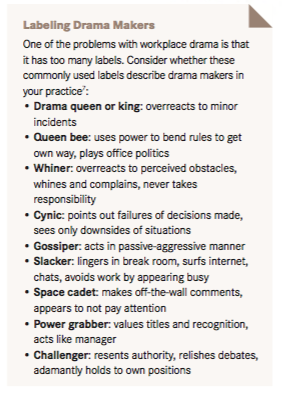Creating a Drama-Free Workplace
Ditch the conflict and develop confident communication to resolve workplace issues.

It’s OK to admit that sometimes we enjoy a little drama — on screen, that is. Reality shows, soap operas, game shows and even news segments feed our need for a little excitement as we watch tension build in on-screen relationships. Where we generally do not enjoy theatrics is in our daily lives, either at home or at work. Drama means conflict, and no one enjoys conflict.
In the workplace, drama results in job dissatisfaction and decreased productivity. Unnecessary drama may lead to symptoms of fear, anxiety and stress among staff, potentially jeopardizing the safety and well-being of patients. Even though many of us say that we hate drama and want to avoid it, the truth is that we often have trouble dealing with it appropriately.

Labeling Drama
It is easy to label coworkers as “gossipers,” “space cadets” or “drama queens” in an attempt to gain a better understanding of why they act the way they do (see Labeling Drama Makers). However, the crux of the problem may actually be the labeling process itself.
For example, labeling someone on your veterinary team as a “whiner” may feel like a step in the right direction for dealing with this person, but often the situation ends with the root cause of the conflict never being resolved, thus allowing the drama to continue — only now with a label.
Let’s say the “queen bee” label is affixed to the manager at your practice. Every time the schedule is handed out, someone on the team makes a comment about how it is “par for the course” or “so-and-so always gets her way.” The label is assigned, but the drama continues. Labels do not solve the drama. Instead, they are used as a type of defense mechanism that fuels even more workplace drama.1
Understanding the Drama Triangle
Workplace drama stems from a dysfunction in work relationships. If team members develop a deeper understanding of “drama relationships,” they can develop confident communication to resolve the real issues at hand. Familiarity with two theories can help: the Karpman drama triangle2 and the empowerment dynamic.3
Karpman Drama Triangle
According to the Karpman Drama Triangle, any given drama includes three players: victim, rescuer and persecutor. These three roles interact with one other as represented in Figure 1.

The victim4 has a “poor me” mentality, does not take responsibility for his or her feelings, and actually sets the stage for a drama triangle to form. Victims have a need to involve others in their conflict; they feel powerless, helpless or hopeless; and they see themselves as unable to handle situations.5
The rescuer is a person who helps relieve the victim of that victimhood. This person has a “let me help you” mentality, setting out to assist but usually offering only short-term repairs that keep the victim dependent on the rescuer. Rescuers have trouble saying no, constantly try to fix other people’s problems, have a need to be the hero and are often considered control freaks.
The persecutor is a person, condition or circumstance that dominates and maintains a one-up position over the victim. Persecutors have a need to win every argument, are defensive and sarcastic, blame others, criticize harshly and justify their behavior.
It’s important to note that a person does not always operate from the same position. For example, Jane (victim) has a problem with Ned (persecutor), so she goes to Pam (rescuer).
Pam talks to Ned, who didn’t realize there was an issue. Ned becomes frustrated and turns to Bill (his rescuer) and asks him to talk to Pam — and the triangulation continues. How might you break that cycle? Have Jane talk directly to Ned, or consider inverting the triangle.
The Empowerment Dynamic
Instead of viewing the drama triangle in negative positions, turn it into a more positive relationship. In the Empowerment Dynamic (Figure 2), the victim is now the creator, the persecutor is the challenger, and the rescuer is the coach.3
In this dynamic, the creator asks, “What do I want?” and thoughtfully evaluates the situation, then chooses appropriate steps toward an outcome rather than focusing on the problem. The challenger asks, “What is my intention? ” and provokes others to take action, such as learning something new or making a decision, then provides an opportunity to choose a response or take action. The coach asks, “How do I see others?” and helps develop a vision and an action plan, then provides encouragement and support.
Notice the difference? There is no more “poor me” victim but, instead, an empowered team member taking responsibility for what he or she wants; no more rescuing but, instead, coaching, supporting and encouraging; no more negative persecutor but, instead, an opportunity or challenge.
Putting the Triangle to Work
Consider this scenario: Kathy has been labeled a “whiner.” As soon as Claire posts the schedule, Kathy starts whining about it. She complains to Dr. Bob, who goes to Claire and requests fixes to the schedule. Claire then adds to the drama by deliberately giving Kathy shifts she doesn’t want. The drama cycle continues, with Kathy as the victim, Claire as the persecutor and Dr. Bob as the rescuer.
It’s time for a change. Kathy needs to think more like a creator, Dr. Bob needs to take on the role of coach, and Claire needs to step in as the challenger. How does this change look?
Dr. Bob must coach and guide both Kathy and Claire to identify what they each want to achieve, what skills or resources they require, what is and is not working for them, and what steps to take next.
Kathy needs encouragement to evaluate what she really wants and then choose appropriate steps, rather than complaining, to achieve a better outcome. Claire needs to admit to her intentions: Is she being passive-aggressive with Kathy, or does she intend to get Kathy to evaluate the situation and make a firm decision?
Unlock the Door
It is never easy to deal with drama. The process becomes even more difficult when we label a single individual and fail to identify other players involved in the conflict. Look at any drama that occurs in your veterinary practice. Is there more than one person involved? Maybe you can begin to see at least three people involved in a drama triangle. Once you identify the players, you unlock the door to finding a quick and easy solution.
Louise S. Dunn is an award-winning speaker, writer and consultant who brings over 40 years of in-the-trenches experience and business education to veterinary management. She is founder and CEO of Snowgoose Veterinary Management Consulting, which helps veterina-rians develop strategic plans that consistently produce results.
References:
- Emerald D. How do we un-label those we have labeled? Power of TED website. powerofted.com/un-labeling-what-you-have-labeled. Published November 11, 2016. Accessed July 19, 2017.
- Karpman, S. The new drama triangles. karpmandramatriangle.com/pdf/thenewdramatriangles.pdf. Published August 11, 2007. Accessed July 19, 2017.
- Emerald, D. The TED triangle. Power of TED website. powerofted.com. Accessed July 19, 2017.
- Johnson, RS. Escaping conflict and the Karpman drama triangle. BPD Family website. bpdfamily.com/content/karpman-drama-triangle. Modified October 6, 2016. Accessed July 19, 2017.
- Forrest, L. The three faces of victim — an overview of the drama triangle. Lynne Forrest website. lynneforrest.com/articles/2008/06/the-faces-of-victim. June 26, 2008. Accessed July 19, 2017.
- McIntyre, MG. Seven employees that drive managers crazy. Your Office Coach website. yourofficecoach.com/topics/lessons_in_leadership/effective_leadership/seven_employees_that_drive_managers_crazy.aspx. Accessed July 19, 2017.
